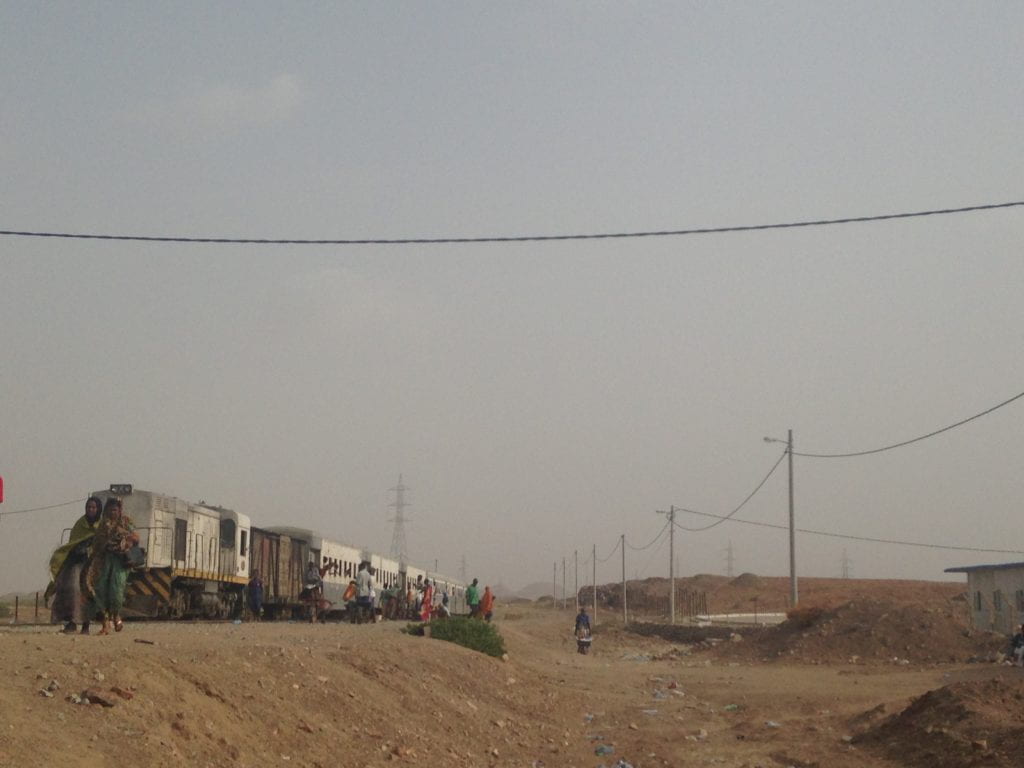The train departs from the station at five in the morning, after the merchandise, suitcases, covert bags of khat, and plastic gas cylinders have been loaded on to fill the overhead compartments, under the seats, and in the spaces between the aisles. More than 100 years old, with graffiti in Amharic, English, French and Somali tracing the walls, the heavily loaded train takes off slowly and then rumbles down the tracks as it begins to rain, leading many of the passengers, including myself, to close the windows and cover themselves in blankets as we get in a couple more hours of sleep.
Later on, as light slips through the cracks in the windows, the train stops at one of the largest towns along the route, Adi Gala, for a lunch break. Some of the merchandise is passed in and out of railway car. Children run onto the train carrying plastic bins of roasted goat meat and bags of cooked spaghetti for our lunch break, as well as large bottles of cold water to sell. Selling lunch food to passengers is just one example of how the railway inspires economic transactions in the towns along the route.
We are traveling from Dire Dawa, a city in eastern Ethiopia, to the border of Djibouti. More than one hundred years ago, this train was built by the French partly as a colonial maneuver to gain access to Ethiopia’s market from the port of Djibouti, where France had its colony, French Somaliland. Throughout the lifespan of the train, small towns have sprung up along the train’s route, with the mostly pastoralist Somali communities in this region of Ethiopia relying on the train for survival, as it both provided access to markets as well as served as the main means of transportation for people who were either traveling from one town to the next, or to the far ends of the route, Djibouti or Addis Ababa.
Now, a century later, the train still runs twice a week through the desert environment in the Somali region of Ethiopia. Over time, the state of the train has declined significantly. Twice over the journey I observe the locomotive at the front part of the train break free from the passenger car and proceed down the tracks, leaving the passenger cars stranded. After reversing back toward us and re-hitching the passenger trains to the locomotive, we continue on.
But even the decline of the train has benefited towns along the route in unexpected ways. One interviewee explained that when the train broke down–which happened pretty often–the towns’ hotel and restaurants industries would benefit from passengers having to get off the train and spend the night. There were even ways in which the decay of the train cars, such as broken seats or doors, provided places to hide contraband goods. Because the train ran slowly, people were able to pass contraband goods from the windows to people walking alongside the train in order to hide them from an upcoming security checkpoint, as another interviewee described. Contraband goods were transported by train from Djibouti to Addis, becoming a huge part of the economy for the towns along the route. This benefited the people living in the towns as they could gain access to cheap clothing and grain from Djibouti and could also sell their agriculture projects to Djibouti without the added cost of taxes. These histories are undoubtedly emotional: When I’ve interviewed people about the history of this train, people call it their “mother and father” and a “life line”—and compared it to the Nile in Egypt as a source of life and sustenance.
As the old train passes from town to town, I begin to see a line of new railroad tracks running parallel to our train, maybe two or three kilometers away, a radiant line in the desert. These are the tracks of the new train, the subject of my research—the “modern” train as many people call it. Although not yet operational, this new train runs almost parallel to the old one. Built by Chinese construction contractors in collaboration with the Ethiopian and Djiboutian governments, the train represents a government-led transformation of Ethiopia’s economy to be more manufacturing-oriented. The differences between the old and new train could not be clearer: “There is no comparison,” one government official told me. Most likely, contraband will be strictly regulated and discouraged. Tickets will likely be more expensive, something that some of my interviewees who hope to be passengers have mentioned and fear.
And unlike the old train, the new train is high speed—that means it doesn’t stop in as many small towns as the old railway. The speed of the train has also reportedly caused some serious problems hitting livestock–sometimes two or three times a month, one worker for the Chinese company reported. Hitting livestock is just one of the disruptions for people who live along the route. There has been a land seizure and compensation process for people whose land fell along the route of the railroad tracks.
Already, the train has had an impact on societies and economies along the route. Some of these changes imply an expansion of cities’ industrial sector, offering hope for new jobs and economic renewal. In the neighborhood where the new railway station was built on the outskirts of the city of Dire Dawa, an industrial zone has been built, as well as new hospitals and buildings, accompanied by higher property values. “The new Dire Dawa will be there,” one interviewee predicted in reference to the neighborhood. What this train will mean for the future of these communities, and what sorts of economies will spring up around it once it becomes operational, remains to be seen.

